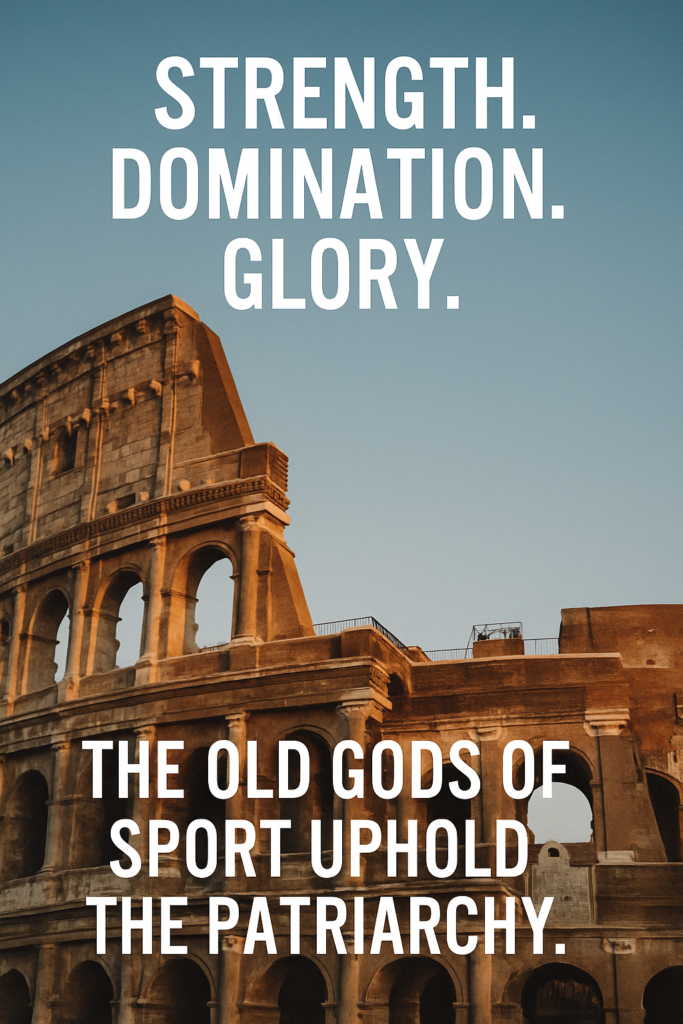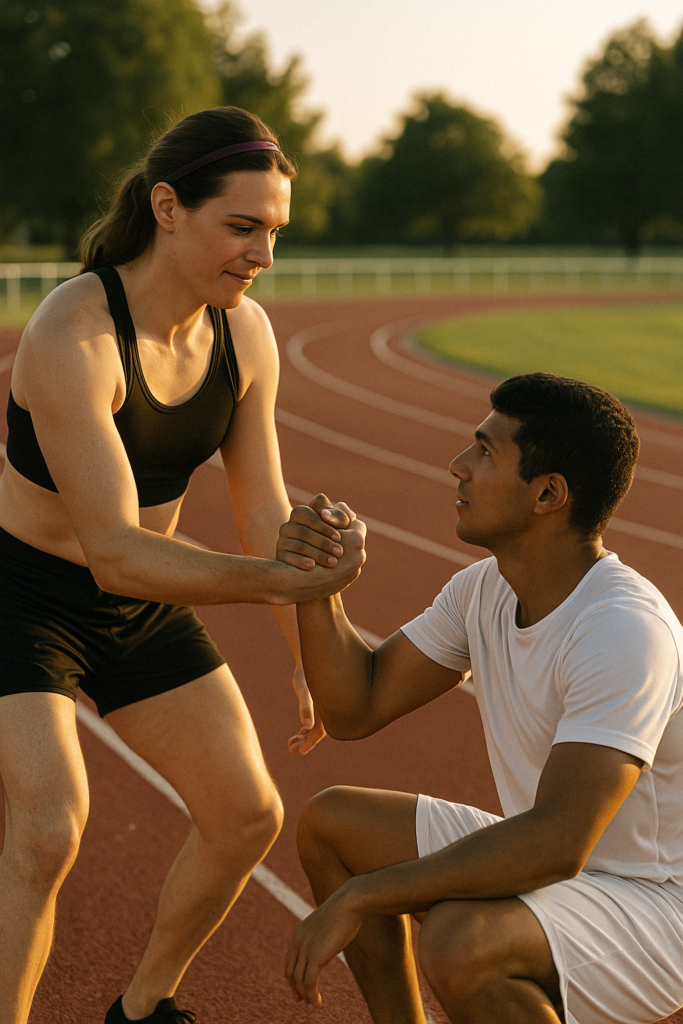What if our idea of fairness in sport wasn’t fairness at all? What if it was a relic of an ancient empire – a system designed for dominance, not justice – that we are still clinging to without realising it?

Sport is often seen as pure. A place where merit wins, where effort is rewarded, and where the playing field is level. But if we look deeper, sport has never been free from the influence of power, politics, or patriarchy. In fact, sport remains one of the last places where the ancient ideals of domination, hierarchy, and strength over vulnerability are openly celebrated.
I want to explore how these old patterns persist, how they are reinforced in young men from childhood onwards, and why true fairness in sport – fairness that includes everyone – demands that we leave behind the blood legacy we’ve inherited.
The Blood Legacy: Sport as a Tool of Empire
Our modern view of sport owes more to the Roman Empire than most people realise. In Rome, sport wasn’t about recreation, health, or unity. It was about control. Gladiatorial games, chariot races, and wrestling matches were designed to glorify male dominance, power, and violence. Strength was virtue. Submission was a weakness. Winners lived; losers died.
This value system – that greatness is about domination and strength – didn’t disappear when Rome fell. To be clear, Rome never truly fell. It rebranded: through the Church, through the British Empire, through modern colonial powers, carrying forward the same ideals of domination, hierarchy, and strength into every corner of the world, including the world of sport. It was absorbed into medieval Europe, fortified by Victorian ideals, and eventually exported globally through colonialism.
Today, many of our most popular sports – football, rugby, athletics, boxing – are structured around these ancient ideals. Winning isn’t just succeeding. It’s proving superiority. Losing isn’t just a result. It’s humiliation.
Women, trans people, and anyone who doesn’t fit the traditional masculine mould have always been marginalised or erased in this system. Sport, as we know it, was never designed for them.
The Adolescent Trap: How Boys Are Programmed to Protect the System
By adolescence, boys are funnelled into this ancient framework without even realising it. Sport becomes one of the main arenas where boys are judged, ranked, and sorted. Winning brings status. Strength brings respect. Vulnerability brings shame.
From school sports days to professional leagues, boys are taught that their value lies in how well they can dominate others physically. Not just in sport, but in life.
This programming creates tribalism:
- Loyalty to ‘your team’ above all else.
- Suspicion and hostility towards ‘the other’.
- A rigid pecking order based on strength, speed, and aggression.
It’s not just innocent competition. It’s social conditioning that shapes how boys view themselves, each other, and the world.
The issues highlighted in contemporary culture – the loneliness, rage, insecurity, and identity crises many boys and young men are facing – are direct results of this outdated programming. A programming that tells them they must dominate or disappear.
Sport: The Last Sanctuary of the Blood Ideals
Most areas of society have slowly begun to challenge old hierarchies. But sport remains one of the final strongholds where blood empire values are not just alive, but celebrated.
Every time we insist that fairness means dividing people rigidly by sex, or that any challenge to the traditional structure is “unfair,” we aren’t protecting sport. We’re protecting the empire’s legacy.
The panic about trans inclusion isn’t about biology. It’s about preserving a system where strength and domination are still seen as the ultimate proofs of worth.
Protecting the old system isn’t just nostalgic. It comes at a real cost.
Women are still sidelined. Trans athletes are demonised.
Anyone who does not embody the ideal of strength, domination, and “natural” superiority is treated as a threat to the purity of sport.
The defence of “fairness” is often a mask for exclusion — a way to keep power and recognition confined to those who have always had it.
Patriarchy isn’t just a legacy. It’s an active structure. And in sport, it continues to sort, exclude, and erase in ways that echo the ancient empire more than modern equality.

The Fear of Change: Protecting Familiarity, Not Fairness
Some argue that restructuring sport, through handicaps or performance-based classifications, would ruin it. “Nobody would watch,” they say. But this fear isn’t rooted in fairness or excitement. It’s rooted in a deep emotional loyalty to the old blood ideals.
We are attached to the world Rome built, not because it is the fairest world, but because it is the one we know. Protecting the familiar feels safer than challenging centuries of programming.
But fairness is not about preserving the past. It is about building a system that reflects the reality of human diversity, not the illusions of the ancient empire.
The Myth of Biological Fairness
Natural ability doesn’t split neatly along sex lines. Some cis women are stronger, faster, and more enduring than many cis men. Hormones, muscle mass, and bone structure – all vary wildly within sexes, not just between them.
Trans women who medically transition lose significant muscle mass, haemoglobin, and strength. They do not retain an unbeatable advantage. Studies show this clearly (Roberts et al., 2020; Harper, 2015). Reviews by bodies like the Canadian Centre for Ethics in Sport also conclude that fears around trans athletes are exaggerated and not grounded in real evidence (CCES, 2016).
International organisations such as the Centre for Sport and Human Rights and UNESCO have made it clear: true fairness and human rights demand inclusive approaches, not exclusion based on outdated ideas (Sport Human Rights Report, 2022; UNESCO Charter, 2017).
The truth is, “biological sex” has always been an imperfect, blunt instrument for dividing athletes. It’s just one we’ve clung to because it props up the old hierarchies we’re too scared to challenge.
A Better Model Exists
If fairness were truly our goal, we would restructure sport around actual ability, not assumptions based on birth.
- In horse racing, male and female horses compete together, with handicaps used to level the field.
- In boxing and martial arts, weight classes are used to group fighters more fairly.
- In the Paralympics, athletes are classified by ability, not by the cause of their disability.
We already accept these models where performance matters more than identity. Applying them more widely would make sport more honest, more inclusive, and ultimately more human.
Compassionate Reflection: It’s Time to Grow Up
Recognising the blood legacy in sport isn’t about shame. It’s about growth.
Boys and men have been trapped in a system that taught them to seek status through dominance. It’s time to set them free. It’s time to create a version of sport that rewards not just strength, but resilience, creativity, teamwork, and heart.
True fairness means challenging the blood empire, not preserving it.

Conclusion: Beyond the Blood Legacy
Imagine sport as a true celebration of human ability in all its forms – strength, speed, endurance, agility, intelligence, and heart.
Imagine a sporting world where success isn’t about who you were born as, but what you have built, trained, and nurtured.
The call for trans inclusion in sport isn’t just about fairness. It’s backed by a growing body of research, ethics, and human rights frameworks that demand a more just future.
If we have the courage to leave the blood legacy behind, sport could become one of the most powerful forces for unity the world has ever seen.
Not a battleground.
A bridge.
Sources:
- International Olympic Committee. Olympics.com
- Women’s Sports Foundation Report (2021). Womenssportsfoundation.org
- Roberts, T. A., Smalley, J., & Ahrendt, D. (2020). Effect of Gender Affirming Hormones on Athletic Performance in Transgender Women and Men. PLOS ONE
- Centre for Sport and Human Rights. (2022). Sport and Human Rights: The Case for Inclusion. Sport Human Rights Report
- Canadian Centre for Ethics in Sport. (2016). Creating Inclusive Environments for Trans Participants in Canadian Sport. CCES Report
- Harper, J. (2015). Race Times for Transgender Athletes. British Journal of Sports Medicine
- UNESCO. (2017). International Charter of Physical Education, Physical Activity and Sport. UNESCO Charter
